
Models & More 1/48 Yokosuka MXY7 'Ohka' Model 22
| KIT #: | MM 02 |
| PRICE: | $40.00 MSRP |
| DECALS: | One option |
| REVIEWER: | Larry Cherniak |
| NOTES: | Short run resin kit with white metal detail parts, 2 vac canopies, and decals. Visit models-n-more.com for availability. |

| HISTORY |
"Life is as the weight of one
feather compared to one's duty"
Such was, ostensibly, the attitude of the Kamikaze pilots of Japan. Named after
a famous typhoon which swept an invading Mongolian fleet out to sea to their
destruction in 1280 AD, the "Divine Wind" "special attack" corps accepted the
concept that their lives were tiny things compared to the cause for which they
fought.
By 1944 little could be done to stop the advance of the American carriers, and
so the bomb-laden suicide aircraft came. By ones and twos at first, they
desperately jinked their way through the Combat Air Patrols of Hellcats and
Corsairs flown by well-trained, experienced and aggressive pilots. Against
defenses directed in by good shipborne radar, few got through and they did
little physical damage. The psychological effect- the horror of, and anger at,
another man so fanatical that he would willingly fly an aircraft into you- was
disproportionately higher though, as I think we can all now understand.
The Franklin and Belleau Wood were hit. Off Iwo Jima, the Saratoga took four
Kamikazes and two bombs and was forced to retire to Pearl Harbor for repairs.
The "Jeep" carrier Bismarck Sea was sunk in the same engagement. The trouble
with the Kamikazes was, they seemed on the verge of working- tactically. Huge
carriers were being stopped for very little expenditure of resources. Yet for
each pilot who got through to complete his mission, perhaps 50 fellow men
drifted dead to the bottom of the ocean.
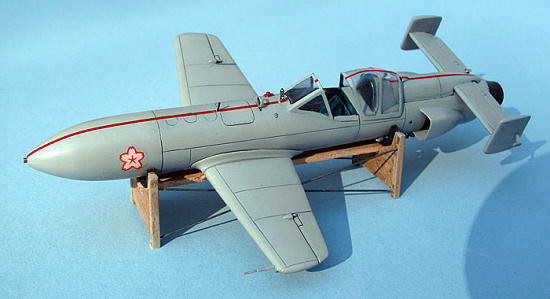 Then, on
April 6, 1945 off Okinawa, the first of ten massed "kikusui" (floating
chrysanthemum) attacks started. Aircraft and pilots had been brought in from the
Japanese mainland, assembled and launched in waves in an attempt to overwhelm
the defenses. 355 Kamikaze were launched. It was a Hellish rain of metal hail,
of 400mph missiles with human minds behind them. Most of the 10th Army's mortar
ammunition was sunk on two transports. The destroyer Colhoun, ablaze and
sinking, had to be scuttled. The destroyer Bush, set on like a wounded animal,
listing and almost helpless after a B6N2 Jill smashed down between her stacks,
was almost cut in half by a Zero hit amidships. She finally was set ablaze by
another strike, broke apart, and sank.
Then, on
April 6, 1945 off Okinawa, the first of ten massed "kikusui" (floating
chrysanthemum) attacks started. Aircraft and pilots had been brought in from the
Japanese mainland, assembled and launched in waves in an attempt to overwhelm
the defenses. 355 Kamikaze were launched. It was a Hellish rain of metal hail,
of 400mph missiles with human minds behind them. Most of the 10th Army's mortar
ammunition was sunk on two transports. The destroyer Colhoun, ablaze and
sinking, had to be scuttled. The destroyer Bush, set on like a wounded animal,
listing and almost helpless after a B6N2 Jill smashed down between her stacks,
was almost cut in half by a Zero hit amidships. She finally was set ablaze by
another strike, broke apart, and sank.
Later, in following kikusui attacks, the Bunker Hill was struck twice in quick
succession, with 400 dead or missing and 250 wounded. After returning from
kamikaze-inspired repairs, the Enterprise CV-6, once the prize of the fleet and
nearly the only thing standing between the Japanese and the remainder of the
free world, was mortally wounded. One of her elevators was blown 400 feet into
the sky by a Kamikaze Zeke, whose bomb had penetrated 5 decks before detonating.
To quote Commander Edward P. Stafford, U.S.N., in "The Big E": "But Chief Pilot
Tomi Zai (his body, with calling cards in his pocket, was found at the bottom of
the elevator well) had done what his superiors in the Imperial Navy had been
unable to do in three and a half years of concerted effort. He had knocked
Enterprise out of the war." On April 16, 1945, the destroyer USS Laffey suffered
31 dead and 72 wounded after being attacked by 22 Kamikaze in 80 minutes in the
third kikusui wave.
Some of the Kamikaze aircraft used were simply bombed-up Zekes (250kg on an
A6M5, 500kg on an A6M7 Model 63), Judys, or even trainers. Specially designed
suicide planes, such as the Ki-115, perhaps even the J8M Shusui, were yet coming
online. Then there was the unique flying bomb, the MXY7 Ohka model 11. Designed
to be carried aloft and dropped from the bottom of a Mitsubishi G4M2e Betty
bomber when 10-20 miles from the target, the Ohka was to glide in close before
firing its three solid rockets. Boosted to 580mph by gravity and 8-10 seconds of
thrust, the Ohka would slip past fighters and AA fire and contact the warship at
the waterline. 2,646 lbs (1200kg) of tri-nitroaminol would do the rest.
That was the plan. In reality, the Betty bombers could rarely get anywhere near
close enough to launch- even with fighter cover- and fell from the sky in
flames. Often, no bombers returned from an Ohka mission, and all the bombs were
dropped harmlessly into the sea- sometimes with a pilot onboard, launched at too
great a range.
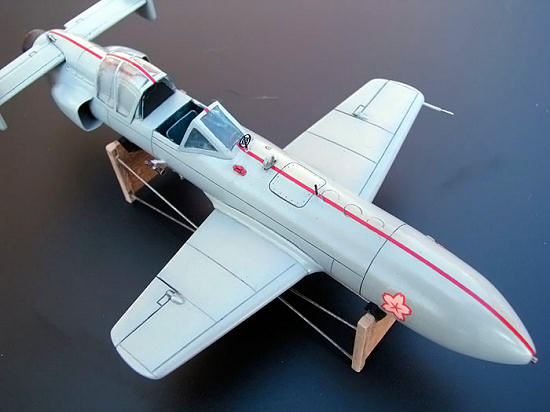 Still, a
few got through. On 12 April, 1945, off Okinawa, the 2,200-ton Sumner-class
destroyer Mannert T. Abele, disabled from an earlier Kamikaze Zero strike, broke
in half and sunk within three minutes of being struck amidships by an Ohka
flying bomb. On 4 May, the light minelayer USS Shea suffered an Ohka strike
which put it out of the war, with 27 men dead and 91 wounded. The bomb, because
of its tremendous velocity, actually passed through the ships bridge structure
before detonating off the port side. The destroyer Hugh W.Hadley had to be
scrapped after a horrendous encounter with up to 100 Kamikaze craft, including
Ohkas, on 11 May.
Still, a
few got through. On 12 April, 1945, off Okinawa, the 2,200-ton Sumner-class
destroyer Mannert T. Abele, disabled from an earlier Kamikaze Zero strike, broke
in half and sunk within three minutes of being struck amidships by an Ohka
flying bomb. On 4 May, the light minelayer USS Shea suffered an Ohka strike
which put it out of the war, with 27 men dead and 91 wounded. The bomb, because
of its tremendous velocity, actually passed through the ships bridge structure
before detonating off the port side. The destroyer Hugh W.Hadley had to be
scrapped after a horrendous encounter with up to 100 Kamikaze craft, including
Ohkas, on 11 May.
The Ohka Model 22 was a weapon built of desperation. Never reaching combat, it
was designed to address some of the Model 11's shortcomings. It featured a
unique Campini-type "jet" engine arrangement meant to extend the range to a safe
distance. This consisted of a 100-HP Hatzukaze piston engine driving a
compressor into which fuel was injected and ignited. It was meant to be carried
aloft under a Yokosuka P1Y3 Model 33 Ginga "Frances", and was given a 33%
smaller wing and half the warhead of the Model 11. At only 276mph airspeed and
with undoubtedly monstrous handling (on the first test flight, it killed the
chief Ohka test pilot when it plummeted out of control immediately upon being
dropped), it is difficult to see how it would have been an effective weapon.
Other planned models were to be powered by the new Ne-20 turbojet and launched
in a variety of ways: Nakajima G8N2 Renzan "Rita" bomber drop, own takeoff,
catapult-launch from land or submarine, or towed behind an aircraft.
Altogether, the deaths of 150 American sailors and wounding of 250 may be
attributed to Ohka attacks. In return, Japanese sources indicate 55-60 Ohka
pilots died, together with 229 Betty pilots and crew. In the Okinawa area in
total, perhaps 2,000 kamikaze missions were flown vs. 5,000 conventional ones.
20 ships were sunk by kamikaze vs. 6 by conventional bombing, and 217 were
wounded by kamikaze vs. 45 by conventional aerial attack. Around 4,900 American
sailors were killed and 4,800 wounded. One can argue, therefore, that the
tactics were working. They were effective. But in the horrible logistics of war,
the suicide bombers from the sky had spent themselves against a vast approaching
wall of steel, to little strategic effect. Hundreds of missions were flown
against radar picket destroyers, for example, when a dedicated run against
carriers or troop transports would certainly have had a more telling effect.
Often, suiciders kept pummeling obviously disabled ships instead of turning to
fresh prey. The Americans learned how to bomb and harass airfields by night as
well as day to help blunt counter-attacks. And one lesson learned too late by
the Americans: perhaps the days of the wooden flight deck were over. When the
Brits entered the fray with their armored carriers, one Kamikaze Zero, such as
put the Enterprise out of commission, was said to have left nought but a small
dent in the 3-inch thick flight deck of the aptly named Indefatigable.
| THE KIT |
 Manufactured
and packed in Argentina by Antares models, this simple but well-made kit
consists of 15 resin pieces, 15 white metal detail parts, 2 vacuformed canopies,
and decals. The parts are cleanly molded with delicate panel lines and very few
bubbles or other imperfections. The metal parts look nasty at first but clean up
nicely. The canopies are of a decent thickness but unfortunately are male
molded, which means soft edges to the framing. The waterslide decals, consisting
of chrysanthemum blossom emblems, red sighting
Manufactured
and packed in Argentina by Antares models, this simple but well-made kit
consists of 15 resin pieces, 15 white metal detail parts, 2 vacuformed canopies,
and decals. The parts are cleanly molded with delicate panel lines and very few
bubbles or other imperfections. The metal parts look nasty at first but clean up
nicely. The canopies are of a decent thickness but unfortunately are male
molded, which means soft edges to the framing. The waterslide decals, consisting
of chrysanthemum blossom emblems, red sighting
 line, and
a selection of numbers (but lacking any stenciling) come on two tiny sheets
protected by paper. Instructions consist of two photocopied (front and back)
pages with hand-drawn assembly drawings, potted history, painting
recommendations (Tamiya and Testors), and a nice 3-view.
line, and
a selection of numbers (but lacking any stenciling) come on two tiny sheets
protected by paper. Instructions consist of two photocopied (front and back)
pages with hand-drawn assembly drawings, potted history, painting
recommendations (Tamiya and Testors), and a nice 3-view.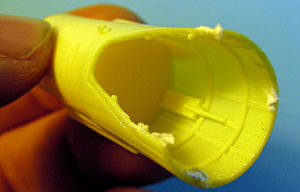
Unfortunately, the wrong picture was accidentally used on both the boxtop and in
the instructions, showing the older rocket-powered Ohka Model 11 (as long
available already in 1/48 kit form by Testors/Hawk). Don't worry, that's not
what's in the box. I talked to Rick Geithmann, the man behind this kit, and he
was aware of the mistake and apologizes for any confusion.
Everything is well packed in separate bags, and a chunk of styrofoam is used to
prevent the delicate cockpit opening from damage. After removing this, I found
some remnants stuck to the resin. A slosh of liquid styrene cement dissolved it
away handily. All in all, a very nice kit in a surprisingly tiny tough cardboard
box. The only conspicuous absences are photoetched bombsight and a display
stand, which you will need to come up with on your own since the craft lacks any
kind of landing gear.
| CONSTRUCTION |
After removing the small casting blocks on all pieces, I
built the simple cockpit pretty much as given, just adding a few wires and a
prominent red release handle to the port side of the panel. If you dig around
enough online you can find some reference pictures of the restored example at
Udvar-Hazy to go by. The instructions recommend using a dark green, but I chose
aotake blue by Model Master (#2119 Interior Metallic Bl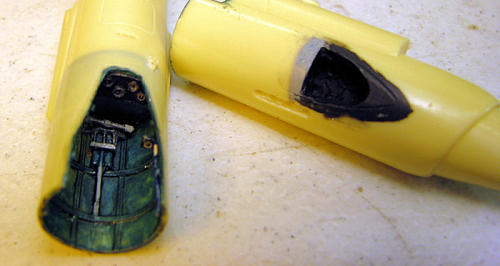 ue)
just to be ornery- because I got a new bottle and wanted to try it out. The seat
as given is OK but lacks the characteristic lightening holes of the original. I
vacuformed a copy using it as a pattern and drilled out some holes, then used
some Eduard seatbelts, but left it out until final assembly.
ue)
just to be ornery- because I got a new bottle and wanted to try it out. The seat
as given is OK but lacks the characteristic lightening holes of the original. I
vacuformed a copy using it as a pattern and drilled out some holes, then used
some Eduard seatbelts, but left it out until final assembly.
When joining up the middle to rear fuselage, the major weakness (literally!) of
the kit came to haunt me. The joint is a simple butt-joint of the
scale-thickness cockpit edge to a solid block of resin. There are no locators
except the cockpit edges to aid alignment, so great care must be taken in
ensuring no twist is introduced at this stage. The cockpit on my sample was
slightly distorted, so I held it in place while CA gluing in stages to recover
the roundness. Even after reinforcing the joint from inside the cockpit with
what I thought was plenty of thick CA, I managed to crack apart the joint two or
three times later. A different design of the kit here would have done wonders. I
recommend dripping in a radius of 5-minute epoxy from the inside- the seat will
cover it up.
The main airframe parts went on pretty well. I glued the wings on so that the
tops matched the wingroot fairings on the fuselage, then filed the undersides of
the fairings to match the wing thickness. I scribed the panel lines a little
deeper and added a few more using the 3-view drawing as a guide. Two you really
should add if you display the cockpit closed are the deep canopy rails.
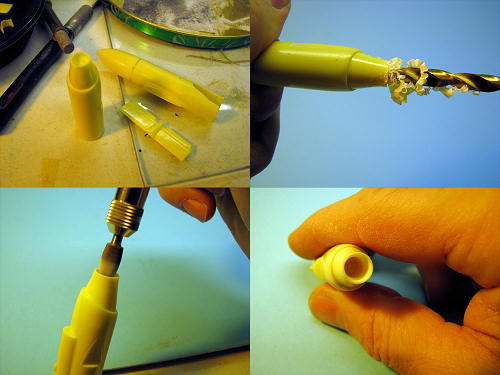 I was
disappointed by the jet air intakes, which are molded solid with a relatively
shallow depression in the front. In this scale you really should have open
intakes. I suppose you could just paint them black, or drill them out. I chose
to replace them altogether with Vac-U-Formed copies (and even took the
opportunity to drill out the fuselage and add compressor blades back there), but
that's because I'm a nutcase.
I was
disappointed by the jet air intakes, which are molded solid with a relatively
shallow depression in the front. In this scale you really should have open
intakes. I suppose you could just paint them black, or drill them out. I chose
to replace them altogether with Vac-U-Formed copies (and even took the
opportunity to drill out the fuselage and add compressor blades back there), but
that's because I'm a nutcase.
Another area that definitely needs drilling out is the jet exhaust, which again
has merely a sunken area. Fortunately, a 1/4" drillbit in a slow battery-powered
drill cleans it right out. While the drill is out, open up a tiny hole in the
nose as well. The vertical tailplanes are simple butt-joins, so you really
should pin them on with tiny music wire as I did. I also added a bit of elevator
actuator detail missing in the kit and a little airscoop or two. Be sure to
carefully and repeatedly sight from the front and rear to make sure everything
stays lined up properly.
The piston engine exhausts are separate tiny metal pieces. I deepened the
locating pips into an ovoid slot before painting. The canopy, once cut free, fit
well. I masked it with metal foil and used Testors clear parts cement to fair in
the windscreen. The framing lines were a bit difficult to follow because of the
radiused edges to the framework.
| COLORS & MARKINGS |
 Although
I did preshading to break up the monotonous paint scheme, this soon disappeared
after I literally broke up the model by dropping it four feet to the cement
floor and had to repaint my repairs! Model Master #2117 IJN sky gray enamel was
used and gave a nice smooth semigloss surface for decals. The only kit decal I
ended up using was the flower logo, which was a bit thick and wanted to stick
fast where positioned. Although it is provided, I used some narrower spare decal
strip for the red line running all the way fore-to-aft.
Although
I did preshading to break up the monotonous paint scheme, this soon disappeared
after I literally broke up the model by dropping it four feet to the cement
floor and had to repaint my repairs! Model Master #2117 IJN sky gray enamel was
used and gave a nice smooth semigloss surface for decals. The only kit decal I
ended up using was the flower logo, which was a bit thick and wanted to stick
fast where positioned. Although it is provided, I used some narrower spare decal
strip for the red line running all the way fore-to-aft.
Polly Scale satin varnish was airbrushed on and it was time for the fiddly bits.
The jetpipe was brush-painted Model Master #1424 burnt iron non-buffing
metalizer lacquer, a really lovely paint. The white metal mass balances were
very nicely done but, again, needed to be butt-joined where they touched. A
spare etched German gunsight was added in front of the windscreen and a sighting
post further forward. A head armor plate was added from black 0.015" styrene. I
built a crude stand using ends from a Dragon Bachem Natter kit stand, wood,
wire, and foam strips, and it was ready to display.
| CONCLUSIONS |
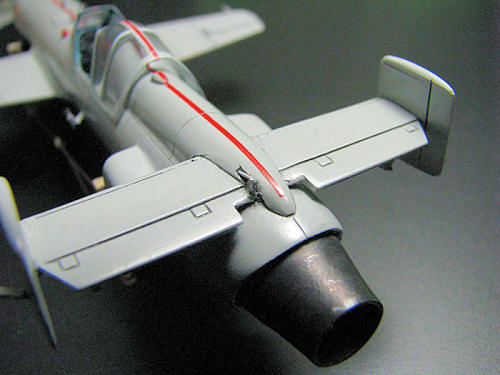 I really
enjoyed building this kit, and it looks great on the shelf. It is a unique
subject and nicely done. It's also a quick build- the additions and corrections
I did were standard operating procedure for me, but you can skip them if you
like. I wish the fuselage were engineered differently for structural soundness
and that the air scoops were open, but if the subject matter interests you,
don't hesitate to pick up this kit while you can. The price is reasonable for
the limited-run nature, and yes the review kit was purchased with my own
hard-earned funds. I look forward to seeing what Models & More will come up with
next!
I really
enjoyed building this kit, and it looks great on the shelf. It is a unique
subject and nicely done. It's also a quick build- the additions and corrections
I did were standard operating procedure for me, but you can skip them if you
like. I wish the fuselage were engineered differently for structural soundness
and that the air scoops were open, but if the subject matter interests you,
don't hesitate to pick up this kit while you can. The price is reasonable for
the limited-run nature, and yes the review kit was purchased with my own
hard-earned funds. I look forward to seeing what Models & More will come up with
next!
| REFERENCES |
"Aero Series no.7 Kamikaze", Aero Publishers. The oldie but
goody (pictures never get old).
"Suicide squads, W.W. II : Axis and Allied special attack weapons of World War
II" by Richard O'Neill. The statistics, dates etc. in the history section were
all taken from this source. ISBN 0312775296
November 2008
Copyright ModelingMadness.com
If you would like your product reviewed fairly and quickly, please contact the editor or see other details in the Note to Contributors.
Back to the Review Index Page 2018